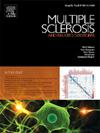Non-invasive brain stimulation enhances the effect of physiotherapy for balance and mobility impairment in people with Multiple Sclerosis.
IF 2.9
3区 医学
Q2 CLINICAL NEUROLOGY
引用次数: 0
Abstract
Background
Impairment of balance and gait is common in Multiple Sclerosis (MS). Non-invasive Brain Stimulation techniques are promising adjuncts to physical therapy to improve disability.
Objective
To determine if combining transcranial direct current stimulation (tDCS) with conventional exercise therapy enhances balance and mobility in people with multiple sclerosis (PwMS) compared to exercise alone.
Methods
In a double-blind randomised controlled trial, PwMS were randomised into a real or sham tDCS group. All patients received individualized exercise treatment. Twelve sessions of real (intensity 2mA, bipolar) or sham tDCS was administered over the primary motor area for 20 minutes followed by one hour of physiotherapy focusing on balance, strength, and mobility, twice a week for six weeks. Outcome measures included balance (Berg Balance Score), mobility (10m Walk Test), fatigue (Fatigue Severity Scale) and quality of life (Multiple Sclerosis Quality of Life - 54) performed 1 week before intervention, at week 7 (1-week post-intervention), and at six months post-intervention. Falls questionnaire was completed 1 week before intervention and at 6 months post-intervention. Generalised linear mixed model analysis was used to compare outcomes at different time points within groups (before and after exercise treatment) and between groups (sham vs real stimulation groups).
Results
Forty participants (mean age 54 and mean EDSS 3.5) were randomly allocated to receive real (n=19) or sham (n=21) stimulation, with 36 completing the post-intervention (real 17, sham 19) and 32 completing the 6-month assessments (real 15, sham 17). All participants had significantly improved balance and mobility scores post exercise treatment (within groups comparison, p<0.05). Between groups comparison found a small but significant improvement in the Berg Balance Score (mean improvement 1.9 and 2 points, p <0.05) and 10-metre Walk Test (mean improvement of 0.09 and 0.11m/s, p <0.05) in the real tDCS group compared to the sham group after six weeks of training and at six months follow-up, respectively. There was no benefit in fatigue, falls and QOL scores in the real stimulation group compared to the control group.
Conclusion
Our results suggest that the addition of tDCS prior to exercise treatment provides a significant improvement in walking speed and balance in people with MS which lasts longer, compared to exercise alone. Further study is needed to optimize the use of this relatively inexpensive and well tolerated device for rehabilitation.
Trial Registration: Australia and New Zealand Clinical Trial Registry (ACTRN12628001836224)
非侵入性脑部刺激能增强物理疗法对多发性硬化症患者平衡和行动障碍的治疗效果。
背景多发性硬化症(MS)患者普遍存在平衡和步态障碍。目的确定经颅直流电刺激(tDCS)与传统运动疗法相结合是否能增强多发性硬化症患者(PwMS)的平衡能力和活动能力。方法在一项双盲随机对照试验中,多发性硬化症患者被随机分为真tDCS组和假tDCS组。所有患者都接受了个性化的运动治疗。在主要运动区进行 12 次真实(强度为 2mA,双极)或虚假 tDCS 治疗,每次 20 分钟,然后进行一个小时的物理治疗,重点是平衡、力量和活动能力,每周两次,持续六周。结果测量包括干预前 1 周、第 7 周(干预后 1 周)和干预后 6 个月的平衡(Berg 平衡评分)、活动能力(10 米步行测试)、疲劳(疲劳严重程度量表)和生活质量(多发性硬化症生活质量 - 54)。在干预前 1 周和干预后 6 个月完成了跌倒调查问卷。结果40名参与者(平均年龄54岁,平均EDSS 3.5)被随机分配接受真实刺激(19人)或虚假刺激(21人),其中36人完成了干预后评估(真实刺激17人,虚假刺激19人),32人完成了6个月评估(真实刺激15人,虚假刺激17人)。所有参与者在运动治疗后的平衡和活动能力评分均有明显改善(组内比较,p<0.05)。组间比较发现,在训练六周后和随访六个月时,真tDCS组与假组相比,在Berg平衡评分(平均提高1.9分和2分,p<0.05)和10米步行测试(平均提高0.09米/秒和0.11米/秒,p<0.05)方面分别有小幅但明显的改善。结论:我们的研究结果表明,与单纯运动相比,在运动治疗前加用 tDCS 可显著改善多发性硬化症患者的行走速度和平衡能力,且改善持续时间更长。还需要进一步研究,以优化这种相对便宜且耐受性良好的康复设备的使用:试验注册:澳大利亚和新西兰临床试验注册中心(ACTRN12628001836224)
本文章由计算机程序翻译,如有差异,请以英文原文为准。
求助全文
约1分钟内获得全文
求助全文
来源期刊

Multiple sclerosis and related disorders
CLINICAL NEUROLOGY-
CiteScore
5.80
自引率
20.00%
发文量
814
审稿时长
66 days
期刊介绍:
Multiple Sclerosis is an area of ever expanding research and escalating publications. Multiple Sclerosis and Related Disorders is a wide ranging international journal supported by key researchers from all neuroscience domains that focus on MS and associated disease of the central nervous system. The primary aim of this new journal is the rapid publication of high quality original research in the field. Important secondary aims will be timely updates and editorials on important scientific and clinical care advances, controversies in the field, and invited opinion articles from current thought leaders on topical issues. One section of the journal will focus on teaching, written to enhance the practice of community and academic neurologists involved in the care of MS patients. Summaries of key articles written for a lay audience will be provided as an on-line resource.
A team of four chief editors is supported by leading section editors who will commission and appraise original and review articles concerning: clinical neurology, neuroimaging, neuropathology, neuroepidemiology, therapeutics, genetics / transcriptomics, experimental models, neuroimmunology, biomarkers, neuropsychology, neurorehabilitation, measurement scales, teaching, neuroethics and lay communication.
 求助内容:
求助内容: 应助结果提醒方式:
应助结果提醒方式:


